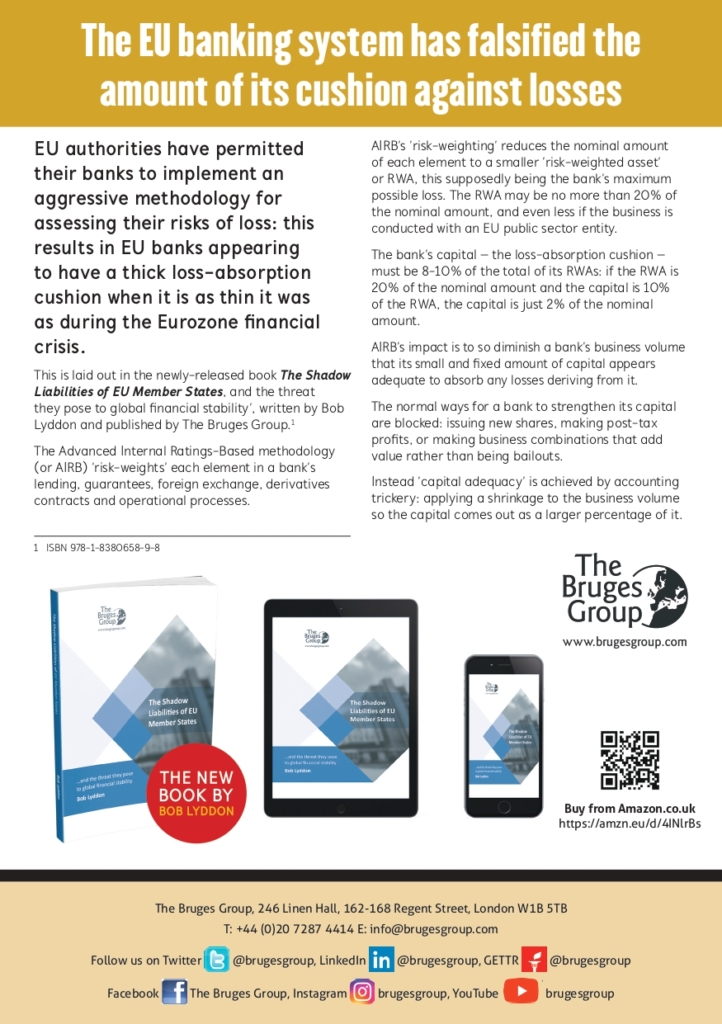Published on 24th May 2023
EU authorities have permitted commercial banks to implement a particularly aggressive form of risk-evaluation methodology, the result of which is the ability to claim a thick loss-absorption cushion and to attest that the EU banking system is stable and resilient. It isn’t: cushions are as thin as before the Eurozone financial crisis.
This is laid out in the newly-released book ‘The shadow liabilities of EU Member States, and the threat they pose to global financial stability’, written by Bob Lyddon and published by The Bruges Group.[1]
EU authorities have blessed an aggressive implementation of the Advanced Internal Ratings-Based methodology (or AIRB) through which banks evaluate the risk-of-loss on both their lending and other on-balance sheet business, and on their off-balance sheet business such as guarantees, foreign exchange and derivatives.
Each piece of business is subjected to a process of ‘risk-weighting’, both for its own characteristics and for the counterparty with whom it is conducted. The result is a so-called ‘risk-weighted asset’ (RWA), representing the risk contained in the piece of business. The RWA inevitably comes out as much smaller than the nominal amount: a mortgage loan of €200,000 will convert to an RWA of €20,000. The RWA of any piece of business conducted with an EU public sector entity will be even lower, because of the incorrect implementation of global rules on what constitutes a risk that merits a 0% risk-weighting. This subject was examined in an earlier book – ‘Managing Euro Risk.[2]
Once the RWA is ascertained, capital needs to be assigned against it, and the normal measure of capital is called Common Equity Tier 1 or CET1: it comprises shareholders equity and retained profits. Banks are obliged to have CET1 of between 8-10% of their RWAs, another diminution: the mortgage loan of €200,000 might require only €2,000 of CET1: 1% of the nominal.
The intention and effect of AIRB are to diminish RWAs to the extent that the bank’s existing and fixed amount of CET1 exceeds the 8-10% threshold. EU banks have been unable to obtain new CET1 through the normal methods: issuance of new shares, making post-tax profits, or making business combinations that add value rather than being bailouts.[3] Instead they have released a certain amount of capital from accounting trickery to do with the valuation and/or sale of bad loans, and have conjured up surplus capital via AIRB.
Monte dei Paschi di Siena is a case in point. It had accumulated a large amount of bad loans. The Italian state owns a majority and has been trying unsuccessfully to sell out. As at 31 March 2021 the bank had CET1 of €5.96 billion, when its nominal assets were €146.66 billion: 4%, or at best half of the CET1 it needed.[4] However, its RWAs were shown on p. 59 as only €48.90 billion giving it a CET1 Ratio of 12%, a comfortable surplus. Risk-weighting diminished the bank’s assets by 66%. The resulting CET1 ratio showed the bank to be in robust good health, so why was it unsaleable?
This is a systemic problem: CET1 Ratios across the EU banking industry show surpluses but this is entirely attributable to the EU authorities permitting AIRB and in the most aggressive manner possible. In reality loss-absorption cushions are wafer-thin, if they even exist at all.
[1] ISBN 978-1-8380658-9-8
[2] B Reynolds, D Blake and R Lyddon, Managing Euro Risk: Saving Investors from Systemic Risk (Politeia, 2020)
[3] For example, the merger of Manufacturers Hanover and Chemical Bank in the 1990s, and not the acquisition by Santander of Banco Popular Espanol
[4] Monte dei Paschi di Siena Group – Consolidated Interim Report – as at 31 March 2021 p. 5 and p. 59

